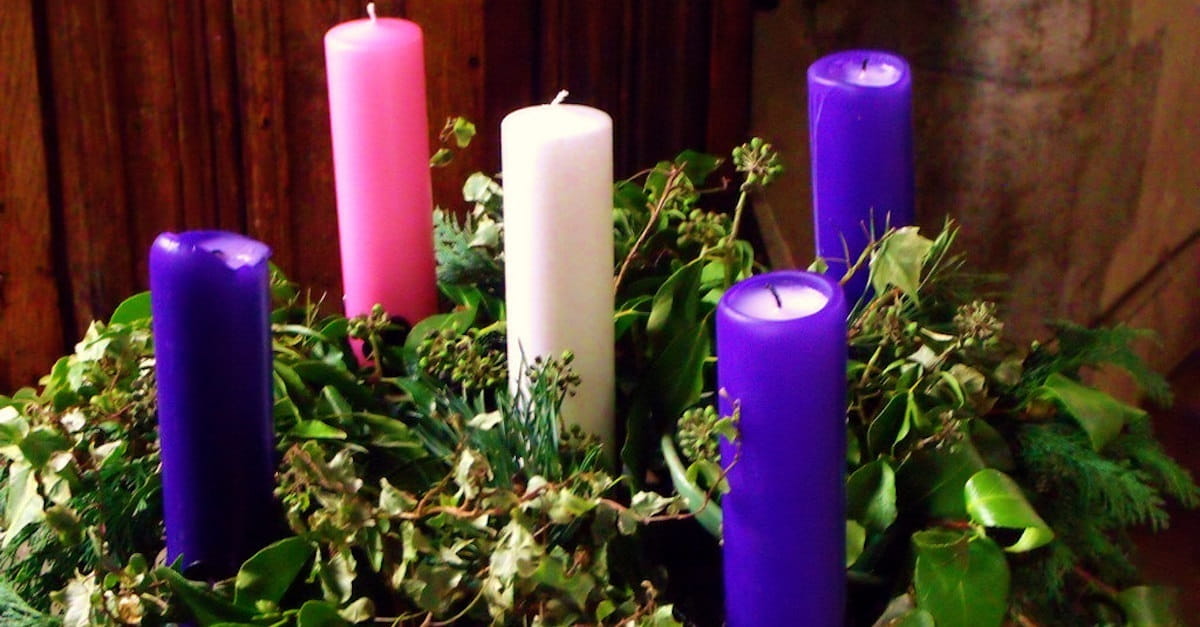Advent is the season of reflective preparation for Christ's Nativity at Christmas and Christ's expected return in the Second Coming.
Prepare for Advent 2023 by knowing this year's holiday dates and Bible readings. Discover the beauty of Advent's history, practices, and symbolism.
Table of Contents
- Advent 2023 Dates
- History and Meaning
- Advent Symbolism
- Advent Traditions
- Wreaths and Candles
- Advent in Christian Life
- Bible Readings for Advent 2023
- Advent Prayer
"The celebration of Advent is possible only to those who are troubled in soul, who know themselves to be poor and imperfect, and who look forward to something greater to come." ~ Dietrich Bonhoeffer
"God of hope, I look to you with an open heart and yearning spirit. During this Advent season, I will keep alert and awake, listening for your word and keeping to your precepts. My hope is in you." ~ Matthew Kelly
"Therefore the Lord himself will give you a sign. Behold, the virgin shall conceive and bear a son, and shall call his name Immanuel." Isaiah 7:14
Advent 2023 - Dates for This Year
The season of Advent lasts four Sundays leading up to Christmas. Each year, Advent will begin on a Sunday between November 27th and December 3rd.
Sunday, December 3rd ~ Start of Advent 2023
Sunday, December 24th ~ End of Advent on Christmas Eve
(Learn more about the start dates for Advent and the four Sundays of Advent at When Does Advent Start?)
What Is Advent? History and Meaning
Some people may know that the Advent season focuses on expectation and think it serves as an anticipation of Christ’s birth in the season leading up to Christmas. This is part of the story, but there’s more to Advent.
The word “Advent” is derived from the Latin word adventus, meaning “coming,” which translates to the Greek word parousia. Scholars believe that during the 4th and 5th centuries in Spain and Gaul, Advent was a season of preparation for the baptism of new Christians at the January feast of Epiphany, the celebration of God’s incarnation represented by the visit of the Magi to the baby Jesus (Matthew 2:1), his baptism in the Jordan River by John the Baptist (John 1:29), and his first miracle at Cana (John 2:1). During this season of preparation, Christians would spend 40 days in penance, prayer, and fasting to prepare for this celebration; originally, there was little connection between Advent and Christmas.
By the 6th century, however, Roman Christians had tied Advent to the coming of Christ. But the “coming” they had in mind was not Christ’s first coming in the manger in Bethlehem, but his second coming in the clouds as the judge of the world. The Advent season was not explicitly linked to Christ’s first coming at Christmas until the Middle Ages.
Get your FREE copy of 25 Days of Advent Devotionals and Readings! Print and share them with family and friends as inspiration this holiday season.
Advent Symbolism
Advent symbolizes the church's present situation in these “last days” (Acts 2:17, Hebrews 1:2) as God’s people wait for the return of Christ in glory to consummate his eternal kingdom. The church is in a similar situation to Israel at the end of the Old Testament: in exile, waiting and hoping in prayerful expectation for the coming of the Messiah. Israel looked back to God’s past gracious actions on their behalf in leading them out of Egypt in the Exodus, and on this basis, they called for God once again to act for them. In the same way, the church, during Advent, looks back upon Christ’s coming in celebration while at the same time looking forward in eager anticipation to the coming of Christ’s kingdom when he returns for his people.
In this light, the Advent hymn “O Come, O Come, Emmanuel” perfectly represents the church’s cry during the Advent season:
O come, O come, Emmanuel,
And ransom captive Israel,
That mourns in lonely exile here
Until the Son of God appears.
Rejoice! Rejoice!
Emmanuel shall come to thee, O Israel.
While Israel would have sung the song in expectation of Christ’s first coming, the church now sings the song to commemorate the first coming and expects the second coming in the future.
Advent Liturgy and Practice
To balance the two elements of remembrance and anticipation, the first two Sundays in Advent (through December 16th) look forward to Christ’s second coming, and the last two Sundays (December 17th – 24th) look backward to remember Christ’s first coming. Over the course of the four weeks, Scripture readings move from passages about Christ’s return in judgment to Old Testament passages about the expectation of the coming Messiah to New Testament passages about the announcements of Christ’s arrival by John the Baptist and the Angels.
While it is challenging to keep in mind amid holiday celebrations, shopping, lights and decorations, and joyful carols, Advent is intended to be a season of fasting, much like Lent, and there are a variety of ways that this time of mourning works itself out in the season. Reflection on the violence and evil in the world causes us to cry out to God to make things right—to put death’s dark shadows to flight. Our exile in the present makes us look forward to our future Exodus. And our own sinfulness and need for grace lead us to pray for the Holy Spirit to renew his work in conforming us into the image of Christ.
One catechism describes Advent spirituality beautifully: “When the Church celebrates the liturgy of Advent each year, she makes present this ancient expectancy of the Messiah, for by sharing in the long preparation for the Savior’s first coming, the faithful renew their ardent desire for his second coming. By celebrating the precursor’s birth and martyrdom, the Church unites herself to his desire: ‘He must increase, but I must decrease.’”
Advent Readings and Themes
Advent readings are themed Scripture readings for each Sunday of Advent. The four weeks of Advent are broken down into the themes:
- Hope (or promise) First Week, December 3rd: Isaiah 9
- Preparation (waiting or prophecy) Second Week, December 10th: Isaiah 40
- Joy (peace) Third Week, December 17th: Matthew 2
- Love (adoration) Fourth Week, December 24th: John 3
One of the beautiful things about the Advent readings above is that they allow churches to include both young and old in their services. The same can be true of private family devotions around the Advent wreath. By this point, you’ve probably realized there are no set criteria for who should read the Advent readings in church. In some denominations, the lead pastor or worship leader may read the Advent reading to lead the congregation in worship.
Read samples of Advent readings in our article Advent Readings for Each Week of Advent
Recommended
Also, read Advent Bible verses at BibleStudyTools.com - The 28 Scriptures can be broken into four weeks with a passage for each day!
Advent Wreaths and Candles

The Advent wreath first appeared in Germany in 1839. A Lutheran minister working at a mission for children created a wreath out of the wheel of a cart. He placed twenty small red candles and four large white candles inside the ring. The red candles were lit on weekdays, and the four white candles were lit on Sundays.
Eventually, the Advent wreath was created out of evergreens, symbolizing everlasting life in the midst of winter and death. The circle reminds us of God’s unending love and the eternal life He makes possible. Advent candles are often nestled in the evergreen wreath. Additional decorations, like holly and berries, are sometimes added. Their red color points ahead to Jesus’ sacrifice and death. Pinecones can symbolize the new life that Jesus brings through His resurrection. Families begin lighting a candle on the fourth Sunday before Christmas and light another candle each subsequent Sunday.
The most common Advent candle tradition, however, involves four candles. A new candle is lit on each of the four Sundays before Christmas. Each candle represents something different, although traditions vary. The four candles traditionally represent hope, faith, joy, and peace. Often, the first, second, and fourth candles are purple; the third candle is rose-colored. Sometimes all the candles are red; in other traditions, all four candles are blue or white. Occasionally, a fifth white candle is placed in the middle and is lit on Christmas Day to celebrate Jesus’ birth.
Excerpt from Advent Wreath & Candles: Understanding the Meaning, History, and Tradition
Advent Prayer
Prayer is a beautiful way to help cut away from distractions of the season and open your heart to prepare for the joy and hope of Christ's birth. Here is a sample prayer to use during the season to focus your heart and mind on the birth of Jesus Christ.
This Advent, Lord, come to the manger of my heart.
Fill me with Your presence from the very start.
As I prepare for the holidays and gifts to be given,
Remind me of the gift You gave when You sent Your Son from Heaven.
The first Christmas gift, it was the greatest gift ever.
You came as a baby born in a manger.
Wrapped like the gifts I find under my tree,
Waiting to be opened, to reveal Your love to me.
Restore to me the wonder that came with Jesus' birth,
When He left the riches of Heaven and wrapped Himself in rags of earth.
Immanuel, God with us, Your presence came that night.
And angels announced, "Into your darkness, God brings His Light."
"Do not be afraid," they said, to shepherds in the field.
Speak to my heart today, Lord, and help me to yield.
Make me like those shepherd boys, obedient to Your call.
Setting distractions and worries aside, to You I surrender them all.
Surround me with Your presence, Lord, I long to hear Your voice.
Clear my mind of countless concerns and all the holiday noise.
Slow me down this Christmas, let me not be in a rush.
In the midst of parties and planning, I want to feel Your hush.
This Christmas, Jesus, come to the manger of my heart.
Invade my soul like Bethlehem, bringing peace to every part.
Dwell within and around me, as I unwrap Your presence each day.
Keep me close to You, Lord. It's in Your wonderful Name I pray.
~Renee Swope, “The Manger of My Heart” from Proverbs 31 Ministries
Read more examples at Advent Prayers and Advent Wreath Prayers
Advent and Christian Life
While Advent is certainly a time of celebration and anticipation of Christ’s birth, it is more than that. It is only in the shadow of Advent that the miracle of Christmas can be fully understood and appreciated, and it is only in the light of Christmas that the Christian life makes any sense.
It is between the fulfilled promise of Christ’s first coming and the yet-to-be-fulfilled promise of his second coming that Karl Barth penned these words: “Unfulfilled and fulfilled promise are related to each other, as are dawn and sunrise. Both promise and in fact the same promise. If anywhere at all, then it is precisely in the light of the coming of Christ that faith has become Advent faith, the expectation of future revelation. But faith knows for whom and for what it is waiting. It is fulfilled faith because it lays hold on the fulfilled promise.”
The promise for Israel and the church is Jesus Christ; The Lord has come to earth and will arrive again. This is the essence of Advent.
(See the author's other posts in this series on Advent by clicking the following links: First Sunday of Advent, Second Sunday of Advent, Third Sunday of Advent, Fourth Sunday of Advent)
Justin Holcomb is an Episcopal priest and teaches theology at Reformed Theological Seminary and Knox Theological Seminary. Justin wrote On the Grace of God and co-authored with his wife Lindsey Rid of My Disgrace and Save Me from Violence. He is also the editor of Christian Theologies of Scripture. You can find him on Facebook, Twitter, and JustinHolcomb.com.
Photo credit: thinkstock-mkucova; Photo credit: flickr/grassrootsgroundswell
This article is part of our larger Advent resource library centered around the events leading up to the birth of Jesus Christ. We hope these articles help you understand the meaning and story behind important Christian holidays and dates and encourage you as you take time to reflect on all that God has done for us through his Son, Jesus Christ!
What Is Advent: Definition & Meaning Behind Christmas Tradition
Advent Bible Verses
Advent Readings
Advent Wreath and Candles Meaning and Symbolism
Advent Prayers
Advent Week 1: The Candle of Hope ~ First Sunday of Advent Prayers and Readings
Advent Week 2: The Candle of Peace ~ Second Sunday of Advent Prayers and Readings
Advent Week 3: The Candle of Joy ~ Third Sunday of Advent Prayers and Readings
Advent Week 4: The Candle of Love ~ Fourth Sunday of Advent Prayers and Readings
Related podcast:
The views and opinions expressed in this podcast are those of the speakers and do not necessarily reflect the views or positions of Salem Web Network and Salem Media Group.
Related video:
What were the prophecies of Jesus' birth in the Bible? How many references did the Old Testament make to the coming of a messiah to save the children of Abraham? See the numerous biblical prophecies of the birth of Jesus Christ and what we can learn from the Old Testament about His divinity in this collection of scripture quotes.








